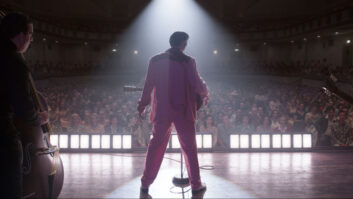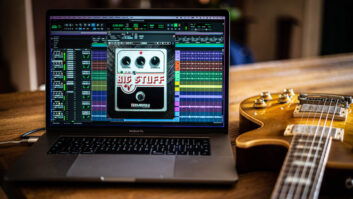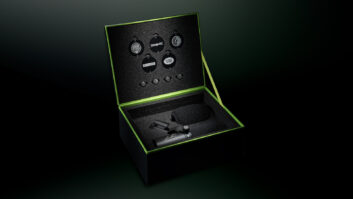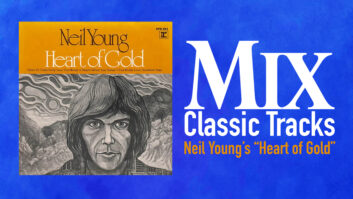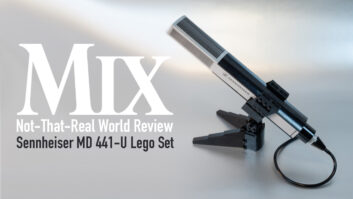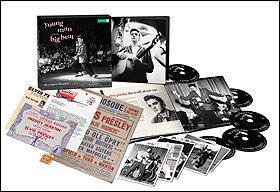
Open this treasure chest and feast your ears and eyes: RCA Legacy’s Young Man With the Big Beat contains five CDs of remastered classics, rare live performances and interviews, plus a vinyl-sized book packed with rare photos and facts, all documenting the year the King rose to national fame, 1956. Included are Presley’s classic versions of “Blue Suede Shoes,” “Heartbreak Hotel,” “Hound Dog,” “Don’t Be Cruel” and dozens more. This is just the latest irresistible package to be culled from RCA’s vaults by producer Ernst Mikael Jorgenson, who has built a career on championing Presley’s catalog. The set was nominated for a Grammy this year in the Best Historical Recording category.
“After he died [in 1977], all you saw of Elvis for 15 years was the bloated Elvis on the front of the National Enquirer,” Jorgenson told The Washington Post reporter David Segal in the article “The Elvis Hunter” in 2003. “The erratic behavior at the end of Presley’s life had overshadowed one of the most important talents in this country. Nobody could hear the music anymore for all the nonsense.”
As often seems to be the case, Europeans fans somehow have a deeper, or at least a different, appreciation for American rock ’n’ roll from American listeners. Jorgenson, a Dane who works out of BMG’s Denmark office, has spent countless hours meticulously researching and documenting every recording session and every performance in Presley’s career, following clues, recovering lost and stolen tapes, and creating collections like this that take a somewhat scholarly, and always passionate, view of Presley’s work.
“In 1988, I was offered a job at the Danish subsidiary for BMG, and when it became known that I was a so-called Elvis expert, I was asked to come up with a game plan for restoring Elvis’ entire catalog,” Jorgenson says. “My [research] partner for all these years, Roger Semon, and I delivered a proposal that was generally accepted, and the first major result was The King of Rock ’n’ Roll 5-CD box in 1992. The box has sold about a million copies worldwide and we received a Grammy nomination for it [for Best Historical Album].

Senior mastering engineer Vic Anesini
Photo: Dominic Costanzo
“I launched the idea [for the Young Man With the Big Beat box set] about three years ago,” he continues. “The idea started out as an extravagant tribute to the first album only. Over the next year, a small group of people kept discussing this release and various angles were considered before we ended up with the project as you now know it. The creative discussion is to me one of the exciting parts of developing projects like these.”
Another creative partner in Jorgenson’s Presley-focused mission has been senior mastering engineer Vic Anesini, a veteran of Sony Legacy’s reissue work who began working on RCA projects when Sony and BMG joined forces several years ago. “The merger between Sony and BMG was one of the greatest things that could have happened for me,” Anesini says. “It opened up a whole new avenue of artists that I get to work with. After having the privilege of mastering all the acclaimed Columbia and Epic artists for 20 years, I now had the opportunity to work on Harry Nilsson, Waylon Jennings, Jefferson Airplane, Elvis Presley; it’s phenomenal.”
Anesini collaborates with Jorgenson mainly via phone and e-mail, though Jorgenson visits the U.S. a couple of times each year to check in with his collaborators and search for ever more Presley facts and recordings.
The Steve Allen Show, Hudson Theater, New York City” />

Elvis Presley performs “I Want You, I Need You,” “I Love You” as his opener on The Steve Allen Show, Hudson Theater, New York City
Photo: Magic Collection
When the scope of a new project was defined, Jorgenson e-mailed Anesini a list of masters to retrieve from RCA’s archives, which are stored in a massive—and massively organized—vault in Boynton, Penn. “It’s a climate-controlled facility where the tapes sit on shelves and everything is bar-coded,” Anesini explains. “It’s amazing how much this system has evolved. When I started in 1988, it was like, ‘Just bring in everything we have and we’ll see if we can find what we need.’ Now everything has been cataloged. Tape archivists brought down all the tapes one box at a time; [they] documented every song, artist and tape format, put a bar code on every tape, so now I can search a massive database and if I need Elvis Presley ‘Hound Dog’—presto—I can see the bar code number, the reel, and I can have it in my room the next day.”
Anesini goes all the way back to the original tapes for every music track he remasters. “This is all the quarter-inch masters,” he says. “Some might be 15 ips, some 30 ips, but this is all the original full-track mono tape.”
His mastering studio is situated in the former Record Plant facility on West 44th Street in New York, now called Battery Studios. The facility has passed through a couple of different owners during the years, but these Walters-Storyk–redesigned rooms have been in continuous operation since the Record Plant opened in the late 1960s in what was Studio C on the building’s 10th floor.
“This facility is amazing to see,” Anesini says, “because it’s the last place John Lennon was before his tragic end, and they kept that mix room where he always used to work, completely intact. It still looks like vintage 1970.”
Anesini has some vintage action going on in his room, as well: “I lucked out because the late, great David Smith, who was our resident rocket scientist at Sony Music studios—who unfortunately passed away too young—designed four mastering consoles with Richie Boisits; literally hand-built them,” he says. “George Massenburg teamed with them on all the components and electronics. These are one-of-a-kind, unbelievably great-sounding consoles. I’m so grateful to be using one of them.”
Some of the engineer’s other treasures include Spitz-modified ATR tape machines with Aria electronics and HDCD Pacific Microsonics A/D converters. “Sony bought these no-longer-manufactured converters and had the foresight to hang onto them. All of our rooms are equipped with these state-of-the-art, great-sounding A-to-Ds,” says Anesini. His monitors of choice are Dunlavy SC4s, which he says are “audiophile darlings. I just love them.”
Jorgenson and Anesini are both committed to a strictly faithful approach to the sonics of Presley’s classic tracks. Their goal is to remain true to the sound that listeners know and remember, and to do that, Anesini says he must dwell in “a reference world. I’m always referring to the vinyl, the listener’s first experience of Elvis. I never just pull up a tape, and say, ‘I think it should be like this.’ Fans have memories of every album that we never want to break with. You don’t want anyone to say, ‘That’s just not how I remember that record.’ So I work hard to preserve those memories.

Presley and his band, The Jordainaires, rehearser for their performance on the Ed Sullivan Show, Maxine Elliot Theater, New York City
Photo: Magic Collection
“I try to bring out what I think are the best qualities of the tape while retaining the original sound, and I’m always referring to previous issues of the music because I don’t want to stray too far from what the fans remember. I wasn’t there when they recorded this material; I wasn’t there when they mixed it and I wasn’t there when they mastered it. So I have to figure out what they did. They may have raised the second verse 2 dB. I don’t know until I actually A/B things.
“You can really get yourself in trouble by thinking, ‘I have the master tape, let me just do what I think sounds best instead of comparing,’” continues Anesini, who also mastered the epic 30-CD Complete Elvis Presley Masters box. “You may think: This is the master take of ‘Jailhouse Rock,’ but it might be an alternate take, and [you don’t know it] because you didn’t compare to the original release. It could even have alternate lyrics. Elvis would record five to 10 takes of a song and really not stray too far vocally.”
Anesini plays back the original analog masters on his ATR machines and does all his mastering through the custom console. “The console directly outputs to the Pacific Microsonics HDCD analog-to-digital converters,” he says. “I use Sequoia as my digital audio workstation to assemble the digital tracks, but all processing—EQ, compression, gain—is done in the analog domain.”
Anesini says that in addition to having wonderful technology at his disposal, it’s also important to understand what technical possibilities or limitations existed in the studio circa 1956. “Usually less is more with a lot of this material,” he observes. “Back in the ’50s, there were certain techniques they would use. Highpass filters: Sometimes the engineers would cut all the extreme low-frequency information because it could cause extreme swings in the cutter head. Sometimes they would cut back on the high end, too, because too much high end and sibilance could cause distortion or damage to the cutter head. And they’d use compression if the levels were too dynamic or to boost overall level. Barring those anomalies, there’s not too much done to the source when they’re going to cut vinyl. A lot of times you put up the tape and the vinyl sounds amazingly close to what they did.”
Of course, the “less-is-more” approach doesn’t necessarily hold up when Anesini is presented with an equal measure of live recordings and radio interviews—all from different sources, recorded differently—that were not necessarily ever intended for public consumption on this level. “The archives have accumulated so much material,” Anesini says. “There are thousands of Elvis tapes in our vaults. They’re little gems. Some of them may be originals, but some are copies. Some of them are not hi-fi. Some of them were recorded off the radio; some could have been somebody holding a mic up to a speaker, but sometimes that’s all you have: a little piece of history.
“Mainly, on those historical recordings, there is some pitch correction,” Anesini continues. “Some of these were done with home recorders, consumer decks, and they may have been recorded at 7.5 or 3.75 ips, and the speed is not always accurate. So we did have to vari-speed a little bit so they would be true and played back in the right key. If the song is supposed to be in A, you don’t want it in G. We check for that.”
It’s Jorgenson and Anesini’s detailed approach to Presley’s music that makes each track a joy to hear, and it’s Jorgenson’s dogged pursuit of all things Presley that enriches each collection they create. Not only is the audio pristine, but the 82-page book shows letters, press clippings, photos, playbill and a timeline that accounts for every musical move Presley made during the year of 1956: the year rock ’n’ roll burst forth as a national phenomenon, the year Presley shook everything up.
“Elvis Presley was my first love in music,” Jorgenson says. “This collection is really to help people remember that what happened in 1956 in the music business has changed the music world forever, and in many ways it all had to do with one artist, Elvis Presley.”
Mix contributing editor Barbara Schultz agrees with Mojo Nixon: “Elvis is everywhere.”


